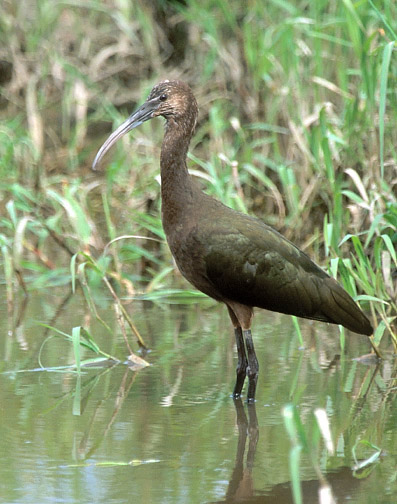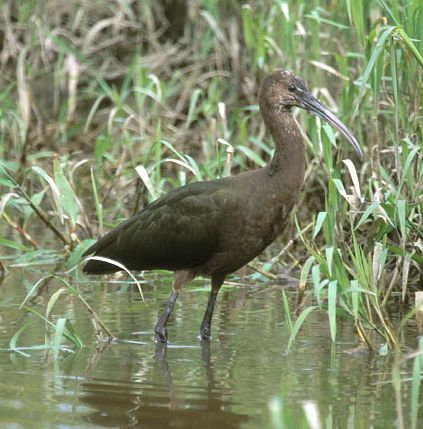

Photo © 2003 Don DesJardin. All rights reserved.
Thanks for calling my attention to this ibis photos I don't mind wading into this identification discussion, as the identification is fairlystraight forward in my opinion.
I am unable to age this individual with 100% certainty based only on the two photos on the web site. The bird is clearly not an adult, and the options are either a bird raised in 2002 and in its second summer or a bird that was raised very early in 2003 and is still only in its first year. My gut reaction (98% certainty) is that this is a second-summer bird, based on the fact that the cheek is a fairly pale brown and appears to be very worn and this individual is already starting its head molt into basic plumage (based on the narrow white streaking that is evident around the face). From my experience, juvenile Glossies do not start their molt into basic plumage by late July--at least the birds that are raised in the mid-Atlantic region, and should not have obviously worn plumage because they have been out of the nest for only a couple of months. But perhaps it is conceivable that a bird raised in a warmer climate could have fledged at an earlier date and may have started its post-juvenal molt by the date you photographed this bird. The photo of the outstretched wing might be adequate to place an age on this bird with 100% certainty based on the stage of wing molt, but I don't believe the bird's age is a critical issue to identify it to species.
Regardless of whether this bird is in its first or second year, the key feature is the presence of the narrow pale lines on the facial skin extending from the eye to the base of the bill. These lines are clearly visible in both photos, and are clearly on the facial skin and not on the feathers. When the young of both species leave the nest, their facial skins are a dull brown color. During their first autumn, Glossies begin to develop the pale lines on the lores that are typical by the adults. The timing varies somewhat from individual to individual, but most young Glossies have developed at least traces of these lines before they migrate from the mid-Atlantic region in September/early October. These pale lines are then retained in all plumage stages for the rest of their lives, although the color and intensity varies with breeding condition, age, and possibly other factors. On White-faced Ibis, the facial skin remains solid brown until they molt into their second alternate plumage during their third year of life. At that point, the facial skin becomes reddish or orangish and the narrow white border to the entire facial skin usually develops on the plumage. It is important to recognize that the white border on White-faceds is on the plumage, not on the facial skin. This border is molted away in basic plumage, when the facial skin becomes solid brown again. So on basic-plumaged ibis, the key feature is the presence of pale lines on the facial skin. If they are evident and restricted to the facial skin, as is clearly the case on this bird, then it has to be a Glossy Ibis.
The presence of pale lines on the lores can become problematic on molting adults, because molting White-faceds can have narrow lines extending from the eye to the base of the bill but have lost the white border behind the eye. On these individuals, it is critical to determine whether the pale lines are on the feathers or on the facial skin, which can be very difficult except under ideal conditions. But usually iris color can be used to identify these individuals. Third-year White-faceds can also have incomplete facial borders, and appear similar to Glossies. But iris color and facial skin color should be helpful to distinguish these birds. But all of these problematic situations involve birds in adult alternate plumage, and appear very different from the bird you photographed.
The absence of pale lines is more problematic, because these lines can be obscured by mud or other factors when the bird is feeding or can be impossible to observe when the bird is distant. This complicates identification of vagrant White-faceds in the east, but in the west, would only cause Glossies to be overlooked except under good vieweing conditions.
Hope this information is helpful. Feel free to share these comments with others. Any submission to the CBRC should include photos of the outstretched wing in order to attempt to age this bird with complete certainty. But in my opinion, those photos are diagnostic for identification purposes.
Bruce Peterjohn
Don provided an additional image of the bird here (note the date on the image is incorrect; it was photographed in August).. Based on the additional image Bruce commented as follows:
This photo makes me less certain of the bird's age--there is no visible evidence of head molt into basic plumage and the presence of obvious white streaks on the throat would seem to suggest an advanced juvenile rather than a second-year bird. The cheek does not look as pale in this photo. Based on the few photos that you have sent to me, I am less certain about the bird's age now, but I believe that its identity is still positively a Glossy based on the face pattern.
This month's mystery bird was photographed 22 July 2003 in Ventura County, California. To view public comments, click here.
 |
 Photo © 2003 Don DesJardin. All rights reserved. |